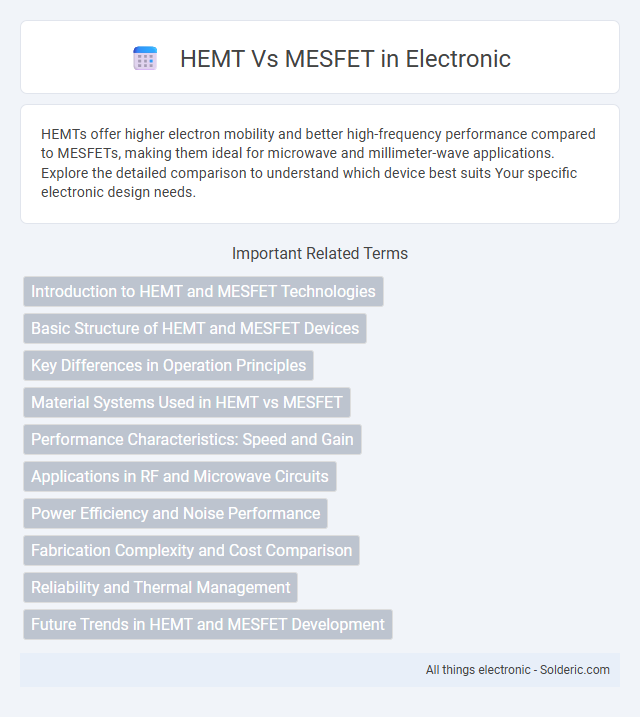HEMTs offer higher electron mobility and better high-frequency performance compared to MESFETs, making them ideal for microwave and millimeter-wave applications. Explore the detailed comparison to understand which device best suits Your specific electronic design needs.
Comparison Table
| Feature | HEMT (High Electron Mobility Transistor) | MESFET (Metal Semiconductor Field Effect Transistor) |
|---|---|---|
| Structure | Heterojunction; uses modulation-doped heterostructure | Schottky metal-semiconductor junction |
| Material | Typically III-V compounds (e.g., GaAs/AlGaAs, GaN) | Primarily GaAs or GaN |
| Electron Mobility | Very high electron mobility due to 2DEG channel | Moderate electron mobility |
| Frequency Performance | Superior high-frequency and microwave performance | Good for microwave frequencies but lower than HEMT |
| Noise Figure | Lower noise figure, suitable for low-noise amplifiers | Higher noise figure compared to HEMTs |
| Power Handling | High power density capability | Moderate power handling capacity |
| Gate Type | Schottky gate with heterojunction | Schottky metal-semiconductor gate |
| Applications | RF amplifiers, satellite comms, radar, low-noise amplifiers | Microwave amplifiers and switches |
| Fabrication Complexity | More complex due to heterostructure growth | Relatively simpler fabrication process |
Introduction to HEMT and MESFET Technologies
HEMT (High Electron Mobility Transistor) utilizes a heterojunction to achieve high electron mobility and faster switching speeds, making it ideal for high-frequency and high-power applications. MESFET (Metal-Semiconductor Field-Effect Transistor) employs a Schottky metal-semiconductor junction, offering simpler fabrication and lower noise for microwave frequencies. Your choice between HEMT and MESFET depends on the specific requirements for speed, power efficiency, and frequency performance in your electronic circuit designs.
Basic Structure of HEMT and MESFET Devices
HEMT devices feature a heterojunction between two semiconductor materials with different band gaps, typically GaAs and AlGaAs, creating a high-mobility two-dimensional electron gas (2DEG) channel for superior electron transport. MESFET devices employ a single semiconductor material, such as GaAs, with a Schottky metal-semiconductor junction acting as the gate, controlling the electron flow in the bulk channel. The heterojunction in HEMTs enables higher electron mobility and faster switching speeds compared to the uniformly doped channel and metal gate structure of MESFETs.
Key Differences in Operation Principles
HEMTs utilize a heterojunction to create a high-mobility two-dimensional electron gas (2DEG), enabling faster electron transport and higher frequency performance compared to MESFETs, which operate based on a depletion-mode Schottky gate controlling a bulk semiconductor channel. The heterojunction in HEMTs results in reduced scattering and higher electron velocity, whereas MESFET operation relies on a single semiconductor material with lower electron mobility. Your choice between HEMT and MESFET should consider application frequency requirements and electron transport efficiency due to these fundamental operational differences.
Material Systems Used in HEMT vs MESFET
HEMT devices primarily utilize wide bandgap III-V compound semiconductor materials such as GaN/AlGaN or AlGaAs/GaAs heterostructures to form two-dimensional electron gas (2DEG) channels, enabling high electron mobility and high-frequency performance. MESFETs are generally fabricated from GaAs or InP semiconductor materials, relying on Schottky gate junctions to control the channel current instead of heterojunctions. The key material difference lies in HEMTs exploiting heterojunction interfaces to improve electron mobility, while MESFETs use bulk semiconductor material with metal-semiconductor gates.
Performance Characteristics: Speed and Gain
HEMT (High Electron Mobility Transistor) exhibits superior speed and gain compared to MESFET (Metal-Semiconductor Field-Effect Transistor), primarily due to its high electron mobility enabled by a heterojunction structure. HEMTs achieve higher cutoff frequencies (fT) often exceeding several hundred GHz, while MESFETs typically operate below 100 GHz. The enhanced electron velocity in HEMTs results in better amplification efficiency and low noise figures, making them preferred for high-frequency and high-power applications.
Applications in RF and Microwave Circuits
HEMTs (High Electron Mobility Transistors) outperform MESFETs (Metal-Semiconductor Field-Effect Transistors) in RF and microwave circuits due to higher electron mobility and superior noise performance, making them ideal for low-noise amplifiers in radar and satellite communication systems. MESFETs are commonly used in microwave power amplifiers and mixers where cost-efficiency and robustness are prioritized. For your RF designs requiring high gain and low noise figure at millimeter-wave frequencies, HEMTs provide enhanced performance and greater reliability.
Power Efficiency and Noise Performance
HEMTs (High Electron Mobility Transistors) demonstrate superior power efficiency compared to MESFETs (Metal-Semiconductor Field-Effect Transistors) due to their higher electron mobility and lower gate leakage currents, resulting in reduced power consumption in high-frequency applications. HEMTs also exhibit better noise performance with lower noise figures, making them ideal for sensitive communication receivers and low-noise amplifiers. When seeking enhanced power efficiency and minimal noise in your RF circuit designs, HEMTs offer a clear advantage over MESFETs.
Fabrication Complexity and Cost Comparison
HEMTs typically involve more complex fabrication processes due to their heterojunction structures requiring precise epitaxial growth techniques, resulting in higher production costs compared to MESFETs, which use simpler metal-semiconductor junctions on single-material substrates. The intricate layering and material quality control in HEMTs demand advanced equipment and cleanroom conditions, contributing to increased manufacturing expenses. Your choice between HEMT and MESFET should consider both the performance benefits of HEMTs and the cost-effectiveness of MESFET fabrication.
Reliability and Thermal Management
HEMT devices exhibit superior reliability compared to MESFETs due to their wider bandgap materials like GaN, which provide higher breakdown voltage and thermal conductivity. Thermal management in HEMTs benefits from efficient heat dissipation, enabling operation at elevated temperatures without performance degradation, whereas MESFETs often require more aggressive cooling solutions to maintain stability. The robust thermal handling and enhanced reliability of HEMTs make them preferable in high-power and high-frequency applications.
Future Trends in HEMT and MESFET Development
HEMTs are advancing with innovations in wide-bandgap materials like Gallium Nitride (GaN), enhancing power efficiency and frequency capabilities for next-generation high-frequency and high-power applications. MESFET technology, while mature, is evolving through improved fabrication techniques to optimize performance in microwave and RF circuits, particularly in cost-sensitive markets. Your choice between HEMT and MESFET will depend on future requirements for power density, frequency range, and cost-efficiency in semiconductor device design.
HEMT vs MESFET Infographic

 solderic.com
solderic.com